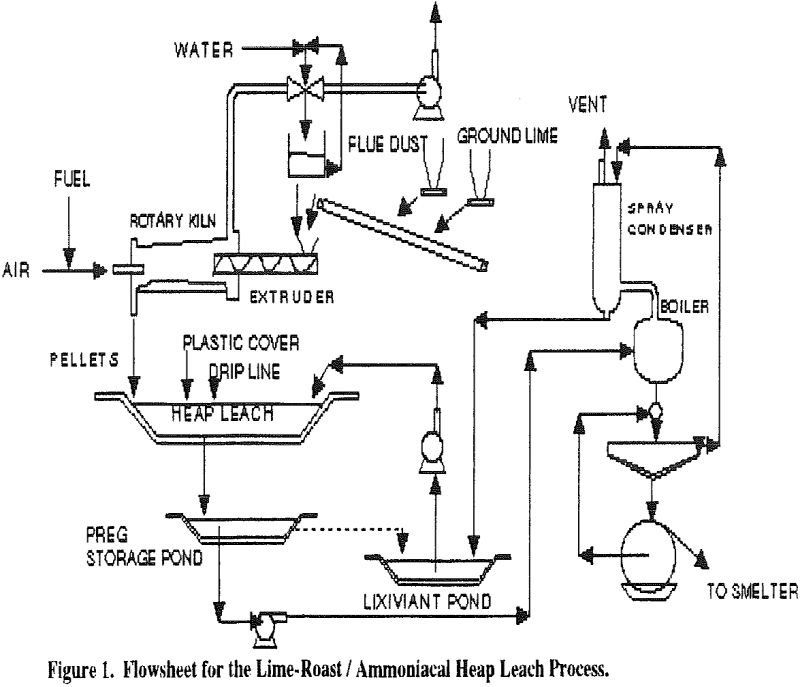Pressure Oxidation of a Refractory Sulfide Concentrate and Thiourea Leaching of Gold and Silver from the Residues

Significant advances have taken place in the treatment of refractory gold ores and concentrates during the past decade. In sulfide ores, pyrite is the most common host mineral for gold. Studies by Gasparrini (1983) showed that gold occurs in pyrite as native gold or electrum in all sizes and forms. Arsenopyrite is probably the second most […]
Peroxide Leaching of Gold Silver Sulfide Flotation Concentrate

The alternatives considered for accelerating the concentrate leach kinetics were addition of air or oxygen, and Degussa Corporation’s peroxide-assisted leaching (PAL) process. Air addition was tried, but only produced a voluminous froth which overflowed the leach tank, because of the presence of residual concentrations of flotation reagents. Therefore, addition of oxygen was ruled out because […]
Leach Pad Cyanide Neutralization

In a “load/unload” gold heap leach operation, the time that a heap is on the reusable leach pad is of critical economic importance. The turnover of heaps must flow in a consistent and cyclic manner in order to leach the gold bearing ore in an economically feasible manner. The process cycle is time dependent on […]
Leaching Nickel & Cobalt from Acid Mine Drainage Sludge

Acid mine drainage sludge is produced when an acid drainage stream is treated with lime, sodium hydroxide, ammonium or sodium carbonate in order to neutralize the acidity of the solution. It was found that a sludge sample taken from southern West Virginia contained significant amounts of nickel, cobalt and manganese. Nickel was 0.26%; cobalt 0.21%; […]
Copper Extraction from Smelter Flue Dust

Process Elements The process flow sheet is shown in Figure 1 and consists of the following steps: roasting a pelletized mixture of hydrated ground lime and flue dust to fix arsenic and sulfur; a venturi scrubber removes dust and any trace of escaping arsenic and sulfur. heap or vat leaching the roasted pellets with a […]
How to do a Mass Balance in Spreadsheet – Excel

The “mass balance” is unquestionably the most common class of problems for the process engineer. Closely related, mathematically, is the “heat balance”. Every laboratory test requires a mass balance to describe the results. Mass balance calculations can be subdivided into several sub-categories based on whether the results are time dependant or not and depending on […]
Heap Leaching Software

Several research groups have spent considerable time investigating coarse ore leaching. Coarse ore leaching includes both heap and dump leaching. The terra “heap leaching” will be used in this paper to mean any type of coarse ore leaching. The results of their work are generally in agreement: the progress of leaching can be described by […]
Geochemical Modeling of in Situ Leaching

An in situ leaching geochemical simulator consisting of flow, mass transport, and graphics support programs has been developed. Two dimensional flow in heterogeneous porous media is modeled using a semi-analytic boundary integral technique. This method involves mapping streamlines to straight line segments in the complex potential plane. Leachant concentration and mineral values are modeled in […]
Regeneration of Activated Carbon used for Recovery of Gold

The process of treating granular activated carbon for return to service in the recovery of gold in Carbon in Pulp and Carbon in Leach circuits has been investigated. Carbons from four U.S.A. mines, one Canadian mine and one South African mine were characterized before and after regeneration. The use of thermal gravimetric analyses demonstrated the […]
In Situ Copper Leaching Operations Hydrologic Design

In situ leach mining (ISLM) is an advanced selective mining technique used for the exploitation of copper oxide deposits. ISLM involves the injection of a solution into a deposit, the dissolution and mobilization of target metals, and the recovery of this solution for processing. The vast supply of raffinate, a sulfuric acid by-product resulting from […]
